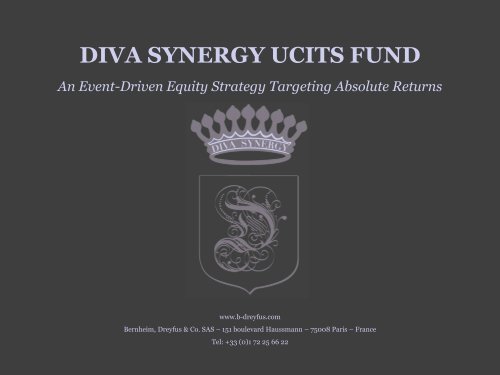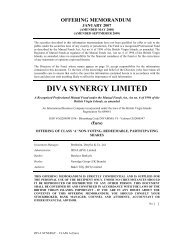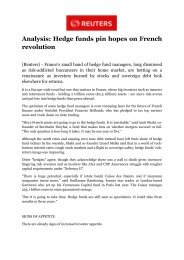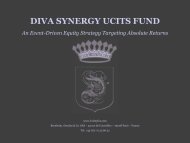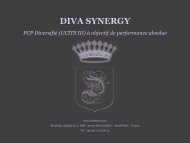DIVA SYNERGY UCITS FUND - Bernheim, Dreyfus & Co.
DIVA SYNERGY UCITS FUND - Bernheim, Dreyfus & Co.
DIVA SYNERGY UCITS FUND - Bernheim, Dreyfus & Co.
Create successful ePaper yourself
Turn your PDF publications into a flip-book with our unique Google optimized e-Paper software.
<strong>DIVA</strong> <strong>SYNERGY</strong> <strong>UCITS</strong> <strong>FUND</strong><br />
An Event-Driven Equity Strategy Targeting Absolute Returns<br />
www.b-dreyfus.com<br />
<strong>Bernheim</strong>, <strong>Dreyfus</strong> & <strong>Co</strong>. SAS – 151 boulevard Haussmann – 75008 Paris – France<br />
Tel: +33 (0)1 72 25 66 22
Disclaimer<br />
The information set forth herein has been obtained or derived from sources believed by <strong>Bernheim</strong>, <strong>Dreyfus</strong> & <strong>Co</strong> to be reliable.<br />
However, <strong>Bernheim</strong>, <strong>Dreyfus</strong> & <strong>Co</strong> does not make any representation or warranty, express or implied, as to the information’s<br />
accuracy or completeness, nor can it accept any responsibility for errors appearing in this presentation. No liability<br />
whatsoever is accepted by <strong>Bernheim</strong>, <strong>Dreyfus</strong> & <strong>Co</strong>, its officers, employees or agents for any loss howsoever arising from any<br />
use of this presentation or its contents or otherwise arising in connection therewith. The information contained in this<br />
presentation shall not be considered as legal, tax or other advise nor does <strong>Bernheim</strong>, <strong>Dreyfus</strong> & <strong>Co</strong> recommend that the<br />
attached serve as the basis of any investment decision.<br />
This document has been provided to you solely for information purposes and does not constitute an offer or solicitation of an<br />
offer, or any advice or recommendation, to purchase any securities or other financial instruments, and may not be construed<br />
as such. Any recipients of this presentation who intend to apply to shares are reminded that any such application may be<br />
made solely on the basis of the information contained in the offering memorandum (“OM”) of the relevant fund, which may be<br />
different from the information contained in this presentation. This document is being circulated by <strong>Bernheim</strong>, <strong>Dreyfus</strong> & <strong>Co</strong><br />
on a confidential basis and is intended exclusively for the use of the person to whom it has been delivered by <strong>Bernheim</strong>,<br />
<strong>Dreyfus</strong> & <strong>Co</strong> and it is not to be copied, reproduced or redistributed, under any circumstances, to any other person in whole<br />
or in part. This document is subject to further review and revision.<br />
This document is for information purposes only and the provisions of the OM of the Funds are the only binding documents. In<br />
the event of any inconsistency, between the descriptions or terms in this presentation and the OM the provisions of the OM<br />
shall prevail. All information in this presentation is subject to change without notice. The copyrights of this Presentation<br />
belongs to <strong>Bernheim</strong>, <strong>Dreyfus</strong> & <strong>Co</strong>.<br />
Warning: Past performances are not a guarantee of future performances. The value of the units may decrease as well as<br />
increase. Any investment may generate losses or gains.
Table of <strong>Co</strong>ntents<br />
Introduction to Diva Synergy <strong>UCITS</strong><br />
Overview of Diva Synergy <strong>UCITS</strong> 1<br />
Investment Strategy 2<br />
Risk Management 6<br />
<strong>Co</strong>mpetitive Advantage 8<br />
Risk Profile 9<br />
Appendices<br />
M&A Market in 2011 10<br />
Merger Arbitrage Portfolio – Case Studies 11<br />
Pre-Event Driven Portfolio – Case Studies 12<br />
Fund Terms and <strong>Co</strong>nditions 13<br />
Portfolio Managers 14<br />
<strong>Co</strong>ntact 15
Introduction to Diva Synergy <strong>UCITS</strong>
Overview of Diva Synergy <strong>UCITS</strong><br />
Diva Synergy is a <strong>UCITS</strong> III compliant Event Driven hedge fund investing in M&A situations in Western<br />
Europe and North America.<br />
Key Facts<br />
Management<br />
<strong>Co</strong>mpany<br />
• <strong>Bernheim</strong>, <strong>Dreyfus</strong> & <strong>Co</strong>.<br />
Structure • <strong>UCITS</strong> III compliant<br />
Strategy<br />
Portfolio<br />
<strong>Co</strong>mposition<br />
• The fund's strategy focuses on M&A<br />
situations<br />
The capital is deployed in two substrategies:<br />
• Merger Arbitrage (announced<br />
deals)<br />
• Pre-Event Merger Arbitrage<br />
(anticipated deals)<br />
• 40 to 50 stocks listed in Western Europe<br />
and North America, usually with a 1 to 10<br />
billions euros market capitalization<br />
• Market neutral with market fluctuations<br />
covered through a zero beta adjustment<br />
• Highly liquid portfolio with on average<br />
80% of positions smaller than 20% of<br />
daily average trading volume<br />
About <strong>Bernheim</strong>, <strong>Dreyfus</strong> & <strong>Co</strong>.<br />
• <strong>Bernheim</strong>, <strong>Dreyfus</strong> & <strong>Co</strong>. is an independent asset<br />
management company specializing in absolute return<br />
strategies, in which the team has strong expertise.<br />
• The objective of <strong>Bernheim</strong>, <strong>Dreyfus</strong> & <strong>Co</strong>., with regards to the<br />
Diva Synergy (<strong>UCITS</strong>) fund, is to offer investors a stable<br />
performance regardless of variations in markets with a<br />
combination of rigorous fundamental analysis and trading<br />
expertise.<br />
• The Portfolio Managers, Sebastien Dettmar, Lionel Melka<br />
and Amit Shabi bring together complementary skills and<br />
have over 40 years experience in trading, asset management<br />
and investment banking (1) .<br />
• <strong>Bernheim</strong>, <strong>Dreyfus</strong> & <strong>Co</strong>.’s capital being wholly owned by its<br />
founders ensures independence.<br />
Target Return • Absolute performance<br />
Target Volatility • 3 – 5 % annually<br />
(1) As at 1/6/2011. www.b-dreyfus.com<br />
1
1. Merger Arbitrage – Announced Deals<br />
The Merger Arbitrage strategy revolves around acquiring shares in listed companies subject to mergers and<br />
acquisitions. The objective is to capture the value gap (spread) between the share price after the<br />
announcement and the price offered by the acquirer.<br />
Different Merger Arbitrage Approaches<br />
" Sure Thing "<br />
• Transactions whose probability of success<br />
is seen as virtually certain: the market has<br />
reached a consensus for the value and the<br />
risk<br />
• Very low risk<br />
" Probable "<br />
• Transactions whose probability of success<br />
is seen as probable<br />
• Transactions with clear synergies but with<br />
contrarian views by market players of<br />
value and risk<br />
" Doubtful "<br />
• Transactions whose probability of success<br />
is seen as doubtful<br />
• High risk transactions with regulatory<br />
uncertainties and/or questionable<br />
synergies<br />
Preference: Strategic deals with clear synergies, low financing and regulatory risks, where both target and acquirer have strong<br />
business models and with contrarian views by market players of value and risk<br />
PORTFOLIO CONSTRUCTION<br />
• Trading Policy: Usually we increase positions when spreads widen – assuming our analysis has not changed<br />
• Hedging: Hedging is used in stock transactions by short selling the amount of the acquirers shares we will receive when deal close<br />
• Liquidity: Over 80% of the portfolio is invested in companies with a market capitalization of at least $500 million.<br />
• Tests:<br />
• Reward/risk ratio – Focus on high reward/risk ratio deals.<br />
• Overlapping deal closure dates to optimize the portfolio’s events calendar<br />
• Monitoring :<br />
• Keep track of portfolio events<br />
• Frequent use of trading limits<br />
• <strong>Co</strong>ntinuous review the investment thesis<br />
2
2. Pre-Event Merger Arbitrage – Anticipated Deals<br />
The Pre-Event strategy consists of identifying potential M&A targets through a rigorous investment process<br />
Investment Process<br />
Target Universe<br />
• 1000 companies of appropriate size in<br />
North America and Europe<br />
<strong>Co</strong>mments<br />
• Investment criteria: <strong>Co</strong>mpanies listed in Western Europe and<br />
North America, usually with a $1 to $10 billions market<br />
capitalization<br />
Under Our Radar<br />
Hot Sectors<br />
Identifying Buyers<br />
• 300-400 potential targets under daily<br />
monitoring<br />
• 100 potential targets within the sectors<br />
identified for a potentially high degree of<br />
M&A activity<br />
• Identification of interested buyers with<br />
cash and a need for external growth<br />
• The selection criteria are both fundamental (consolidation within<br />
an industry, strategic or regulatory pressure, similar to a target of<br />
recent mergers and acquisitions ...) and technical (abnormal<br />
returns, unusual volume / volatility)<br />
• Currently we anticipate strong M&A in the pharmaceutical, energy<br />
and technology industries among others,<br />
• Identification of potential buyers is based on criteria such as:<br />
• Level of cash on balance sheet, need for external strategic<br />
growth, etc.<br />
• <strong>Co</strong>mpanies that could generate synergies and cost savings<br />
and/or unlock other value<br />
Portfolio<br />
• Hedged against market risk<br />
• Mainly companies whose market capitalization is between 1 and 10 billion euros<br />
• Trading Policy: the size of the position normally starts small and is built up when the stock price increases, which we consider as an indication<br />
that the market aligns with our scenario.<br />
• Hedging: the positions are covered by short selling index futures to obtain a zero beta adjustment (ie, "market neutral").<br />
• Liquidity: over 80% of the portfolio is invested in companies with a market capitalization of at least $500 million.<br />
• Risk <strong>Co</strong>ntrols: stop-losses at 10% downside of the traded pair (long equity – short index)<br />
3
2. Pre-Event Merger Arbitrage – Anticipated Deals<br />
Examples of potential investments based on current M&A themes<br />
Investment Theme<br />
Potential Targets<br />
Increasing exposure to emerging markets<br />
Baby Oil being acquired by emerging players<br />
Big Pharma facing patent expiration and looking to plug<br />
their pipeline holes<br />
Underexploited iconic brands<br />
4
Structure of Portfolio<br />
Market Volatility<br />
Investment Strategy<br />
The investment strategy revolves around two pillars: Announced Merger Arbitrage (announced deals) and<br />
Pre-Event Merger Arbitrage (anticipated deals)<br />
Portfolio Structure<br />
1. Announced Merger<br />
Arbitrage<br />
• Announced M&A Deals<br />
2. Pre-Event Merger<br />
Arbitrage<br />
• Identify potential M&A<br />
targets<br />
• To achieve the target return and volatility, the allocation between<br />
the two strategies is adjusted depending on the economic cycle<br />
and market conditions<br />
• 40 to 50 stocks listed in Western Europe and North America<br />
• Market fluctuations systematically covered (Market-Neutral)<br />
Portfolio Allocation<br />
• The structure of the portfolio and the allocation between the<br />
two strategies Pre-Event Merger Arbitrage and Announced<br />
Merger Arbitrage depends mainly on the level of volatility in<br />
the market. Higher market volatility results in higher risks<br />
which gives larger spreads and therefore makes the<br />
Announced Merger Arbitrage strategy more profitable than<br />
the Pre-Event Merger Arbitrage .<br />
• As illustrated below there is a clear correlation between the<br />
structure of our portfolio and the market volatility. At the<br />
end of 2008 when volatility – in terms of the VIX (1) index –<br />
was above 40 more than 90% of the portfolio (managed by<br />
the same team, applying the same strategy) was invested in<br />
the Merger Arbitrage strategy.<br />
Historical Portfolio Allocation - (managed by the same team, applying the same strategy)<br />
Pre-Event Driven Portfolio Merger Arbitrage Portfolio VIX<br />
100%<br />
80%<br />
60%<br />
40%<br />
20%<br />
0%<br />
Q1<br />
2007<br />
Q2<br />
2007<br />
Q3<br />
2007<br />
Q4<br />
2007<br />
Q1<br />
2008<br />
Q2<br />
2008<br />
Q3<br />
2008<br />
Q4<br />
2008<br />
Q1<br />
2009<br />
Q2<br />
2009<br />
Q3<br />
2009<br />
Q4<br />
2009<br />
Q1<br />
2010<br />
Q2<br />
2010<br />
Q3<br />
2010<br />
Q4<br />
2010<br />
Q1<br />
2011<br />
Q2<br />
2011<br />
60<br />
50<br />
40<br />
30<br />
20<br />
10<br />
0<br />
(1) An indicator of U.S. financial markets volatility. The index is calculated by averaging the volatilities on put and call options on the S&P500.<br />
5
Risk Management<br />
A Robust Risk Management System<br />
Regulatory<br />
environment<br />
• The Fund is under French law and complies with the European <strong>UCITS</strong> III regulations<br />
• The Fund is eligible for life insurance<br />
Position Sizing<br />
• Sizing is determined by liquidity, the downside risk and the ability to hedge undesired risks<br />
• We aim to avoid crowded trades<br />
• We systematically cover all risks (currency, interest rate, ...) other than those inherent to the strategy (mainly the nonoccurrence<br />
of an anticipated event)<br />
Internal Risk<br />
Monitoring<br />
• The team has real time access to exposures by sub-strategy, geography, currency and other exogenous or macro factors<br />
often difficult to predict<br />
• Crowded, illiquid or high-risk trades (when any), are segregated and very closely monitored<br />
• Strict stop-loss policy<br />
Stress-Tests<br />
• Risk manager frequently runs stress scenarios on the portfolio and its sub-books and also ensures that our strict<br />
guidelines are respected<br />
• Monthly Risk <strong>Co</strong>mmittee meetings address potential risk areas and raise early warning signals<br />
Frequent<br />
Reporting<br />
• Daily NAV and monthly reporting<br />
6
Risk Management<br />
Risk Management Tools<br />
DATA FEED & ANALYTICS<br />
FRONT TOOL<br />
DAILY RISK REPORTING<br />
• Bloomberg:<br />
- Yield curves<br />
- Market prices<br />
- Currency rates<br />
- Data and other statistics<br />
• Fimatrix®:<br />
- Value at risk<br />
- Stress testing<br />
• Real time position tracking and<br />
exposure updates<br />
• Real time profit and loss calculation<br />
• Cross asset class risk consolidation<br />
• What-if analysis<br />
• Scenario analysis<br />
• Fimatrix®<br />
• In house reports<br />
7
<strong>Co</strong>mpetitive Advantage<br />
Unique Portfolio<br />
<strong>Co</strong>nstruction<br />
• Dynamic optimization of the portfolio allocation between the two strategies (Merger Arbitrage and Pre-Event Driven) to<br />
achieve the target return and volatility regardless of the business cycle and market conditions<br />
Experienced<br />
Management<br />
Team<br />
A Focus on<br />
Discipline<br />
Tactical<br />
Flexibility<br />
Proven<br />
experience<br />
• <strong>Co</strong>mplementary profiles in mergers and acquisitions, trading and asset management<br />
• A thorough knowledge of several industries<br />
• An extensive network of contacts established over the years<br />
• A rigorous investment process<br />
• Strict buying and selling policies<br />
• Ongoing monitoring of performance indicators and portfolio risk<br />
• The team's expertise in fundamental analysis, trading and investment behavior, allows it to make a quick reading of the<br />
market and adjust the portfolio accordingly<br />
• A good understanding of complex transactions<br />
• <strong>Co</strong>rriente/Resources; Apache/Mariner; Hospira/Javelin<br />
• An indepth understanding of the EU Antitrust process<br />
• Oracle/Sun Microsystems; Intel/McAfee; Tom Tom/Tele Atlas; Nokia/Navteq<br />
• A good understanding of the dynamics of hostile transactions<br />
• Kraft/Cadbury; Sanofi/Genzyme<br />
• A solid track-record of identifying potential M&A targets<br />
• Solvay/Rhodia; International Power/GDF Suez; Rio Tinto/Alcan<br />
• Nimble Approach to Risk<br />
• BHP Billiton/Potash; BASF/CIBA<br />
8
Diva Synergy (Ucits) Risk Profile<br />
The Fund may be exposed to the following main types of risks. Any of these risks may cause a significant fall<br />
of the Fund’s Net Asset Value.<br />
• Risk of capital loss: Investors are warned that the capital they invest is not guaranteed and therefore they may not receive back the full amount<br />
invested.<br />
• Risk of non-occurrence of the announced or anticipated merger or acquisition: Merger arbitrage consists of taking advantage of the difference<br />
between the current stock price of the target and the price offered by the acquirer (the spread). If the transaction is completed, a gain consisting of<br />
the spread is realised. However, if the transaction fails to complete, a loss is likely to be incurred as the anticipated control premium usually paid to<br />
the target shareholders by the acquirer is lost.<br />
• Risk of not achieving the Fund’s objective - discretionary management risk: The Fund relies on the managers’ ability to assess the value of<br />
companies and determine the outcome of mergers and acquisitions situations. There is a risk that the Fund may not be invested in the bestperforming<br />
situations at any given time.<br />
• <strong>Co</strong>unterparty risk: In the case of products traded over the counter (OTC), the Fund may have to bear additional risks related to counterparty<br />
exposure. This risk measure the losses incurred by the Fund in respect of commitments entered into with a counterparty. The default of the<br />
counterparty may cause a significant decrease in the net asset value (NAV) of the Fund. In general, these transactions are entered into in line with<br />
regulatory requirements such as collaterals and margin calls.<br />
• Foreign exchange risk: The Fund buys and sells securities denominated in currencies other than the Fund’s currency. In spite of its policy of<br />
hedging the invested assets, the Fund’s net asset value may be adversely impacted if changes in the foreign exchange markets negatively affect gains<br />
generated over two hedging periods.<br />
• Interest rate risk: The Fund may be up to 100% exposed to short-term interest rate risk via debt securities and money market instruments. Interest<br />
rate risk is the risk associated with a rise in interest rates, which can trigger a fall in the price of certain debt securities and money market<br />
instruments, and thereby a fall in the net asset value of the Fund<br />
• Credit risk: The risk of a downgrade in the credit rating of an issuer, or of that issuer defaulting. The value of the debt instruments in which the<br />
Fund is invested may fall, which could result in a fall in the net asset value.<br />
• High-yield risk: There is also a high-yield risk arising from the fact that the Fund may invest in high-yield bonds (rated at least B- by Standard &<br />
Poor’s or Caa1 by Moody’s). These securities carry a significant risk of default.<br />
9
Appendices
M&A Market in 2011<br />
Positive market outlook for mergers and acquisitions (+55% in Q1 2011)<br />
DRIVERS /<br />
CATALYSTS<br />
CONSTRAINTS<br />
CONSEQUENCES<br />
• Savage cost cutting, capital raising and debt refinancing , strong balance sheets – to be opportunistic if a deal is presented<br />
• Attractive price of assets<br />
• Buying growth through acquisition may be more attractive than organic growth - given concerns about the pace of<br />
recovery of Europe and the United States<br />
• Growing pressure on firms to focus on core activities and spin off the rest<br />
• Low interest rates<br />
• Access to credit<br />
• Market volatility<br />
• Antitrust<br />
• Due to lower equity market ratings and the constraints on credit greater proportion of stock to be used for M&A rather<br />
than cash<br />
• Need for a crystal clear strategic rationale<br />
• More hostile bids<br />
• Buyers with strong balance sheets likely to take advantage to snap up rivals at bargain prices<br />
• <strong>Co</strong>rporate activity will be focused on cost-cutting rather than the bull-market justification of buying growth<br />
• Creativity in structuring transactions and managing volatility in stock deals will be key differentiating factors<br />
10
Merger Arbitrage Portfolio – Case Studies<br />
Oracle / Phase Forward (PFWD US)<br />
Apache / Mariner Energy (ME US)<br />
Novartis / Alcon (ACL US)<br />
Activity<br />
• Medical software for hospitals and clinical<br />
institutions<br />
• $213 million turnover<br />
• 300 clients and over 10,000 clinical trials<br />
• Exploration and production of hydrocarbons<br />
(180m barrels of proven reserves)<br />
• Offshore (85%) and Onshore (15%)<br />
• 45% of sales in the Gulf of Mexico<br />
• World leader in eye care<br />
• $6.5 billion turnover<br />
• 300 clients and over 10,000 clinical trials<br />
Key Figures /<br />
Deal Terms<br />
• Market capitalization: $700 million<br />
• EBITDA: $30 million<br />
• Price: $17.00 per share<br />
• Break-up fee: 3.5%<br />
• Market capitalization: $2.3 billion<br />
• EBITDA: $571 million<br />
• Price: $7.8 + 0.17 of stock in Apache for each<br />
Mariner Energy<br />
• Break-up fee: 2.5%<br />
• Market capitalization: $44 billion<br />
• 2.8 of stock in Novartis for each Alcon<br />
• Nestle will receive $180 per share for the<br />
block of 52% (25% were acquired at $143 is a<br />
weighted average price of $ 168)<br />
Rationals<br />
• Strengthening the market for medical<br />
applications<br />
• Should benefit from Obama ‘s reform of the<br />
health system<br />
• Single asset in deep drilling<br />
• Geographical complementarities<br />
• Novartis and Alcon have highly<br />
complementary product portfolios that cover<br />
more than 70% of the worldwide vision care:<br />
pharmaceuticals and surgical contact lenses<br />
• Eye care is a growing market because of<br />
significant needs of an aging population<br />
Risks<br />
• Funding: No risk (Oracle has $13 billion in<br />
cash)<br />
• Antitrust: The deal is passed May 27 in<br />
second request to the United States. The risk<br />
focuses on the timing of review (the market is<br />
quite fragmented and dominated by<br />
Medidata)<br />
• Shareholder vote (June 22): low risk (friendly<br />
deal with a 30% premium)<br />
• Funding: $ 800 million (Apache has 2 billion<br />
on its BS)<br />
• Antitrust: HSR received May 3<br />
• Shareholder vote Mariner: very low risk given<br />
the premium (45%) and recent events<br />
• MAC clause: very restrictive definition,<br />
excludes any particular event or change in<br />
legislation affecting the industry<br />
• According to the Swiss stock exchange<br />
regulations it only requires the approval of a<br />
majority shareholder (Nestle up to vote)<br />
• Legally, Novartis is not forced to improve its<br />
offer, despite the different treatment of<br />
minorities<br />
• However, we believe that Novartis will<br />
eventually raise its offer (employees hold 6%<br />
of capital + reputational risk)<br />
Closing Date<br />
• Late of August 2010 • Late of August 2010 • Beginning of April 2011<br />
Performance<br />
• Discount to offer price: 2.5%<br />
• Return: 10% annualised<br />
• Discount to offer price: 6%<br />
• Annualized return: 25%<br />
• Discount to offer price: -8% (downside)<br />
• Final bid-price: $168 per share<br />
• Annualized return: 12%<br />
11
Pre Event Driven Portfolio – Case Studies<br />
International Power (IPR LN )<br />
Mobistar (MOBB BB)<br />
Mead Johnson Nutrition (MJN US)<br />
Activity<br />
• Electricity production<br />
• 4 million customers in UK<br />
• Gas 60%; <strong>Co</strong>al 20%; Other 20%<br />
• Mobile Telecommunication<br />
• 3 operators in Belgium: Proximus (41%),<br />
Mobistar (31%) and Base (28%)<br />
• Main shareholder France Telecom with 52%<br />
• Baby food (the Enfamil brand)<br />
• Former division of Bristol Myers Squibb (IPO<br />
in February 2009 spin-off in December 2009)<br />
• 60% of sales in emerging markets<br />
Key Figures<br />
• Revenue 2009: £3.5 billion<br />
• Market capitalization: £4.7 billion<br />
• EBITDA: £1.5 billion (42.8% margin)<br />
• Revenue 2010: €1.7 billion<br />
• Market capitalization: €3 billion<br />
• EBITDA: €550 million (32% margin)<br />
• Revenue 2010: $3.1 billion<br />
• Market capitalization: $13.5 billion<br />
• EBITDA: $780 million (7.3% margin)<br />
Valuation<br />
• EV/EBITDA: 7x<br />
• PER: 10x<br />
• Yield: 4%<br />
• EV/EBITDA: 6x<br />
• PER: 12x<br />
• Yield: 6%<br />
• EV/EBITDA: 14x<br />
• PER: 29x<br />
• Yield: 1.6%<br />
Potential<br />
Acquirers<br />
• GDF Suez: Discussions late 2010 that were<br />
stalled after:<br />
(1) price<br />
(2) operational structure<br />
• Strong geographical completion to other<br />
players, IPR is present in UK and Middle East<br />
• E.ON, Enel or Gas Natural<br />
• France Telecom: the new management<br />
(Stéphane Richard) is conducting a strategic<br />
review of investments<br />
• The group suffered setbacks after M&A:<br />
Teliasonera, Egypt, Switzerland, ...<br />
• Mobistar is a simple operation, readable,<br />
accretive and synergistic.<br />
• Nestle (just to collect $ 28 billion from the<br />
sale of Alcon)<br />
• Danone (turned down talks in 2009 - ideal<br />
for Numico)<br />
• Unilever (diversification into higher-growth<br />
segment such as personal care)<br />
• Heinz<br />
Catalysts<br />
• The company represents a prime target in a<br />
deregulated country without protectionist<br />
barriers<br />
• <strong>Co</strong>mplex decision process in France given the<br />
ownership of GDF (State, Albert Frère, ...)<br />
• Very low valuation (plant replacement cost<br />
estimated to 380p)<br />
• Mature market for 3 operators<br />
• Only mobile operator<br />
• Limited capex costs<br />
• High Yield pending buyout of minority<br />
• The stock has doubled since the IPO (results,<br />
growth)<br />
• Unquestionably the finest assets in the<br />
industry with consumer exposure / fertility in<br />
developing countries<br />
• Significant potential synergies for the<br />
purchaser (distribution networks, R & D, ...)<br />
Upside • Return on Investment: 25% • Target price: €60/share (upside: 30%) • Target price: $ 85/share (upside: 30%)<br />
12
Fund Terms and <strong>Co</strong>nditions<br />
Classification • <strong>UCITS</strong> III compliant fund<br />
ISIN <strong>Co</strong>de • Class A (EUR) : FR0011042514; Class E (EUR) : FR0011042472<br />
• Class B (USD) : FR0011042316; Class M (USD) : FR0011042498<br />
Inception Date • 1/06/2011<br />
Type • Event Driven<br />
Investment universe • Europe and North America<br />
Minimum Subscription • Classes A (EUR) , B (USD) : 100 k€ / 100 k$<br />
• Classes E (EUR) , M (USD) : 100€ / 100$<br />
Subscription Fee • 2% maximum<br />
Redemption Fee • 0%<br />
Management Fee • Classes A (EUR), B (USD) : 2.0%<br />
• Classes E (EUR), M (USD) : 2.5%<br />
Performance Fee • 20% above capitalized (EONIA)<br />
Liquidity • Daily<br />
Recommended Investment Horizon • 3 years<br />
Life Insurance eligibility • Yes<br />
Custodian • RBC Dexia Investor Services Bank France<br />
Auditor • KPMG<br />
13
Portfolio Managers (as at June 1 st 2011)<br />
Solid and complementary experience in mergers and acquisitions, trading and asset management<br />
Lionel Melka<br />
<strong>Co</strong>-Manager & Head<br />
of Research<br />
• Lionel started his career in 1998 with Lazard Frères, where he undertook numerous M&A advisory engagements for blue<br />
chip clients (LVMH, Saint-Gobain, Casino, France Telecom, Thomson, Air Liquide, Kingfisher) in a large scope of<br />
situations: privatizations, friendly and hostile takeover bids, LBOs, asset disposals and IPOs Then he joined the M&A<br />
Department of Calyon, where he worked on various advisory assignments in the TMT-Defence team and LCF Rothschild<br />
in 2005 where he led many M&A cross-border assignments in various industry sectors.<br />
• Lionel is also a teacher at the University of Paris Dauphine, one of the leading academic institutions in Europe, in the<br />
fields of corporate finance, asset allocation and alternative investments.<br />
Amit Shabi<br />
<strong>Co</strong>-Manager & Head<br />
of Trading<br />
• Amit is an ex-commander of an analyst team in a military intelligence unit of the Israel Defense Forces.<br />
• After completing 3 years of army service, Amit moved to Paris to pursue his studies and obtained a Master’s degree in<br />
Finance from Sorbonne University.<br />
• Amit Started his career in the strategy department of LCF Rothschild Asset Management.<br />
• After this experience in traditional asset management, Amit worked in the Capital Markets divisions of MAN Group and<br />
Cantor Fitzgerald as a sales of sophisticated financial instruments for hedge funds, institutional and HNWI investors.<br />
Sebastien<br />
Dettmar<br />
<strong>Co</strong>-Manager & Head<br />
of Risk Management<br />
• Sebastien started his career as research assistant in the Algebraic Geometry Laboratory of the Montpellier University of<br />
Science. He developed several models on the resolution of the singularities based on the works of Alexander<br />
Grothendieck.<br />
• In 2001, Sebastien joined LCF Rothschild Asset Management as Risk Manager (€15bn AuM) where he established the<br />
strategic direction, risk tolerance standards, and ethical culture for the asset management activities. After three years<br />
spent as Risk Manager of the company, Sebastien became Head of Quantitative Research.<br />
www.b-dreyfus.com<br />
14
<strong>Co</strong>ntact<br />
<strong>Co</strong>ntact<br />
Amit Shabi<br />
<strong>Bernheim</strong>, <strong>Dreyfus</strong> & <strong>Co</strong>. SAS<br />
151 boulevard Haussmann<br />
75008 Paris<br />
Tel: +33-1-72-25-66-22<br />
Fax: +33-1-76-73-28-10<br />
Email: diva@b-dreyfus.com<br />
ISIN<br />
Bloomberg<br />
• Class A (EUR) : FR0011042514<br />
• Class E (EUR) : FR0011042472<br />
• Class B (USD) : FR0011042316<br />
• Class M (USD) : FR0011042498<br />
• Class A (EUR) : <strong>DIVA</strong>SYA FP<br />
• Class E (EUR) : <strong>DIVA</strong>SYBE FP<br />
• Class B (USD) : <strong>DIVA</strong>SYB FP<br />
• Class M (USD) : <strong>DIVA</strong>SYM FP<br />
15


